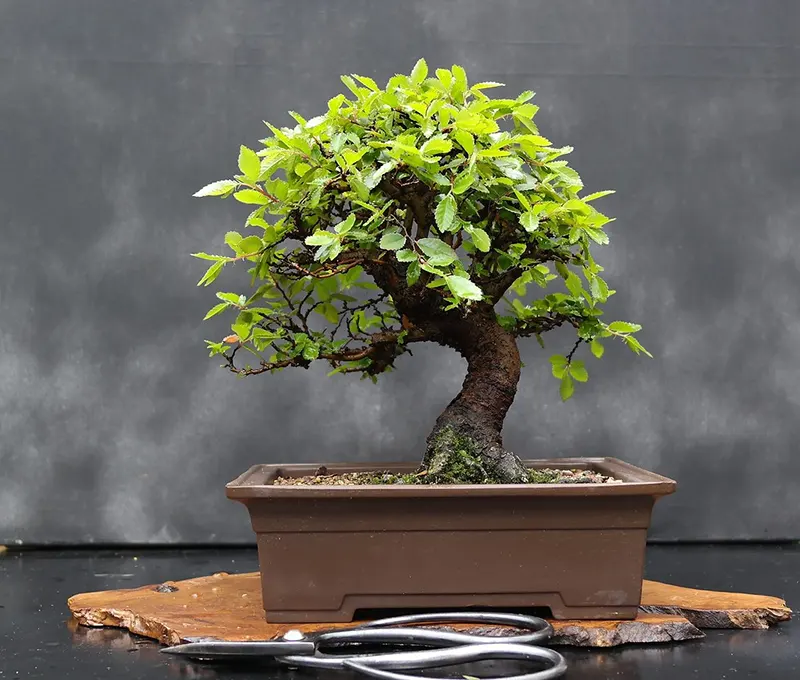Chinese Elm Bonsai: Indoor or Outdoor?
The Chinese Elm is a beautiful tree and bonsai. However, many newcomers to this tree often wonder where best to keep it. Here we’ll discuss the benefits of keeping a Chinese elm indoors and outdoors, as well as the daily needs of the bonsai. Depending on your climate, a mix of moving the plant inside and outside may be the best option for its survival.
Image courtesy of Jerry Norbury / License Details
Indoor Benefits
There are many reasons to keep a Chinese elm bonsai indoors, especially during winter. Here we’ll look at how the indoors regulates climate, provides sunlight, and aids water retention.
Climate Control
Keeping your Chinese elm bonsai indoors during the winter and hot summers allows you to regulate the temperature and humidity levels. This benefit is especially great if you’d like to keep your tree as an evergreen. When the bonsai gets exposed to cold weather for extended periods, it begins to lose its leaves and hibernate.
Sunlight
The Chinese elm requires either full sun or partial shade. When placed indoors near a sun-facing window, the tree will receive enough light to sustain itself. This placement allows it to receive sunlight without being subject to environmental factors and can easily be shielded from harsh light on hot days.
General Indoor Benefits
There are a few minor benefits to keeping any bonsai indoors, mainly the ease of maintenance. Watering your tree is quicker, and the soil will often retain its moisture for longer, letting you water the bonsai less frequently.
Outdoor Benefits
While there are many benefits to keeping the bonsai indoors, there are a few reasons to grow the Chinese elm outdoors. The tree is exposed to more sunlight and enjoys warmer temperatures during the spring and summer months. However, partial shade is required for the summer afternoon sun.
High Sunlight Exposure
With more sunlight, the Chinese elm bonsai receives more nutrients. These excess nutrients help the plant grow and thrive. In an area with partial shade, especially in the afternoon, the bonsai receives plenty of sunlight and is protected from the summer sun.
Warmer Temperatures
Warmer temperatures help the Chinese elm thrive. While it can endure frost, the warmer temperature ensures the soil dries out. Having the soil reliably dry out will ensure you avoid damage to the tree’s roots, which could potentially kill it.
Care for Your Chinese Elm
Knowing how to best care for your bonsai can help you decide where best to keep it. Choosing a location for the Chinese elm specifically has minimal impact.
Daily Sunlight
To thrive, the Chinese elm requires the standard five hours of sunlight exposure a day. As long as this amount is provided, location won’t matter for your bonsai. However, More sun is best, mainly achieved with outdoor placement.
Watering Needs
The Chinese elm suffers in a prolonged drought or an abundance of water. You’ll need to carefully check that the soil has dried each time before watering. The frequency of this process will vary depending on whether you grow the bonsai indoors or outdoors, as outside the bonsai is likely to require water more frequently.
Climate
The Chinese elm is frost-hardy and can survive some exposure to frost. This resistance is ideal regardless of where you keep your tree during the winter months.
Indoors or Outdoors
Ultimately, the Chinese elm bonsai belongs indoors and outdoors, changing its location as the seasons pass. The tree will survive and thrive for most of the year when left outdoors. However, as winter comes, the plant needs shelter indoors to protect it.
When to Move the Chinese Elm Indoors
Too much sun can damage a Chinese elm, especially hot afternoon sunlight during the summer. This overexposure to light can damage branches, leaves and dry out the soil too quickly, robbing the tree of nutrients.
The main time you’ll want to move a Chinese elm tree indoors is when late autumn approaches and for winter.
Moving Around
With the right conditions, a Chinese elm can grow indoors as an evergreen all through the year. At times, moving the bonsai around the house or even outdoors may help it thrive, especially if you have minimal sunlight exposure indoors. The most important factor when deciding where to keep the elm is where you can give it the most nutrients, which will change with the amount of care provided and your climate.







